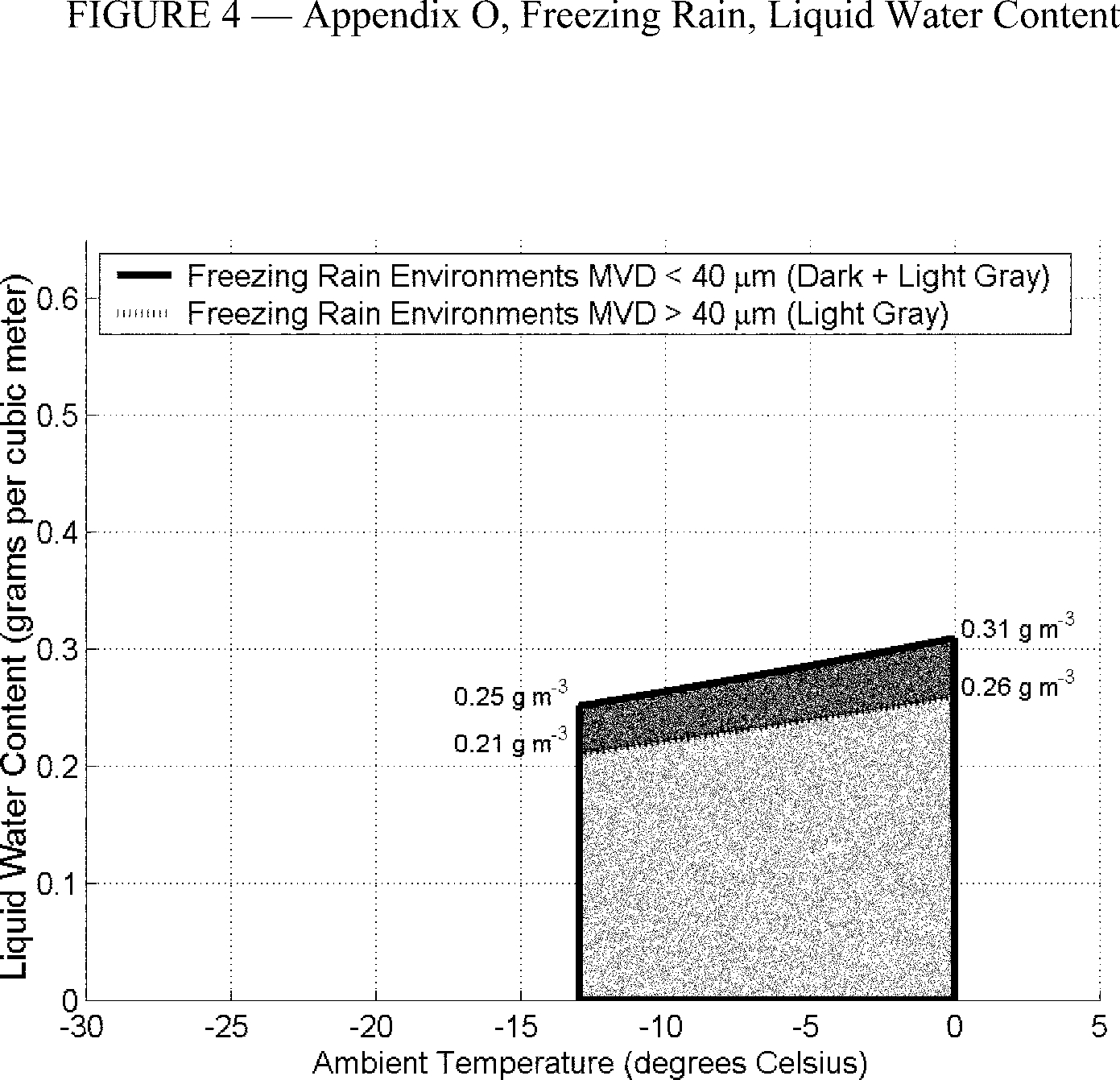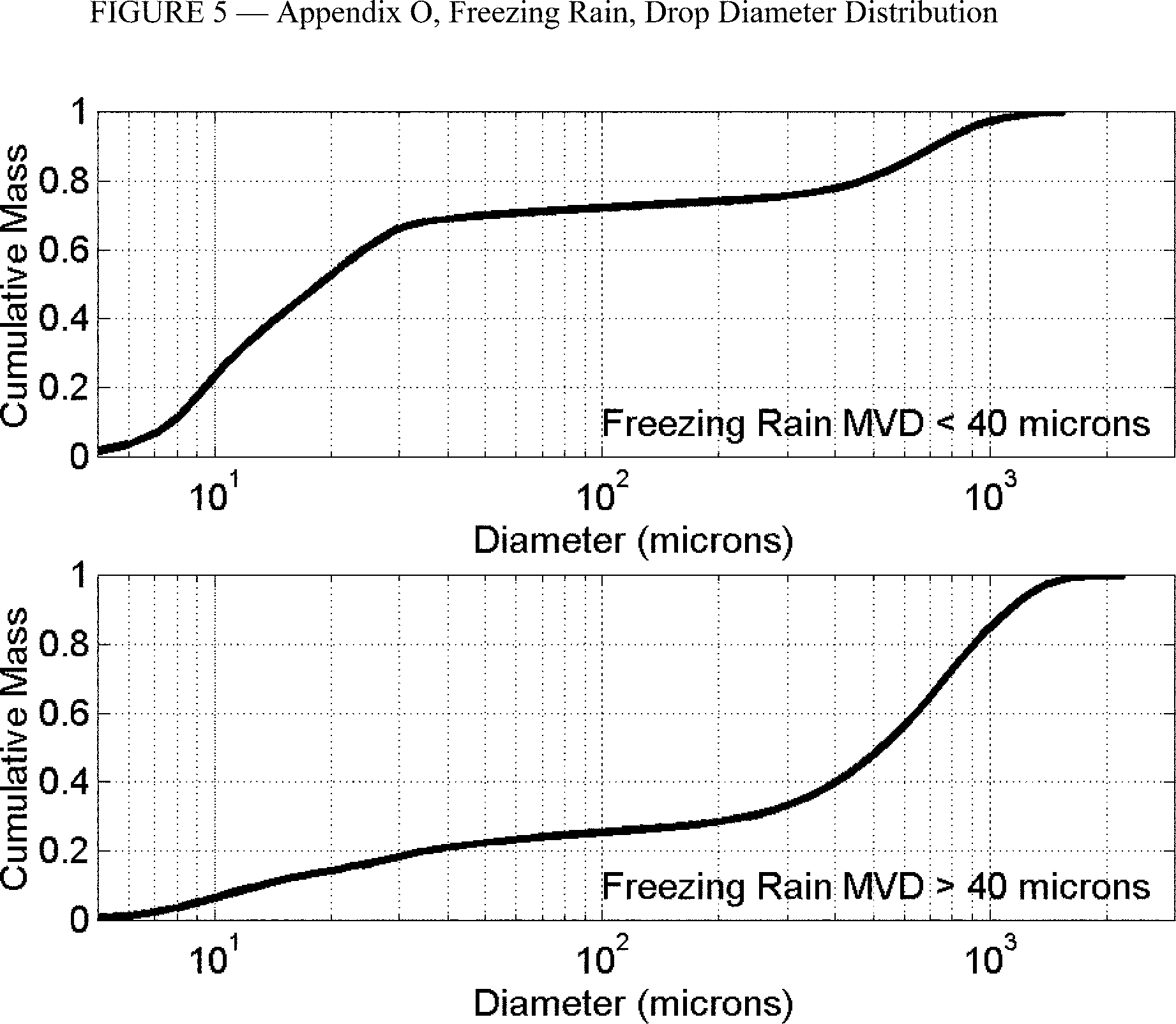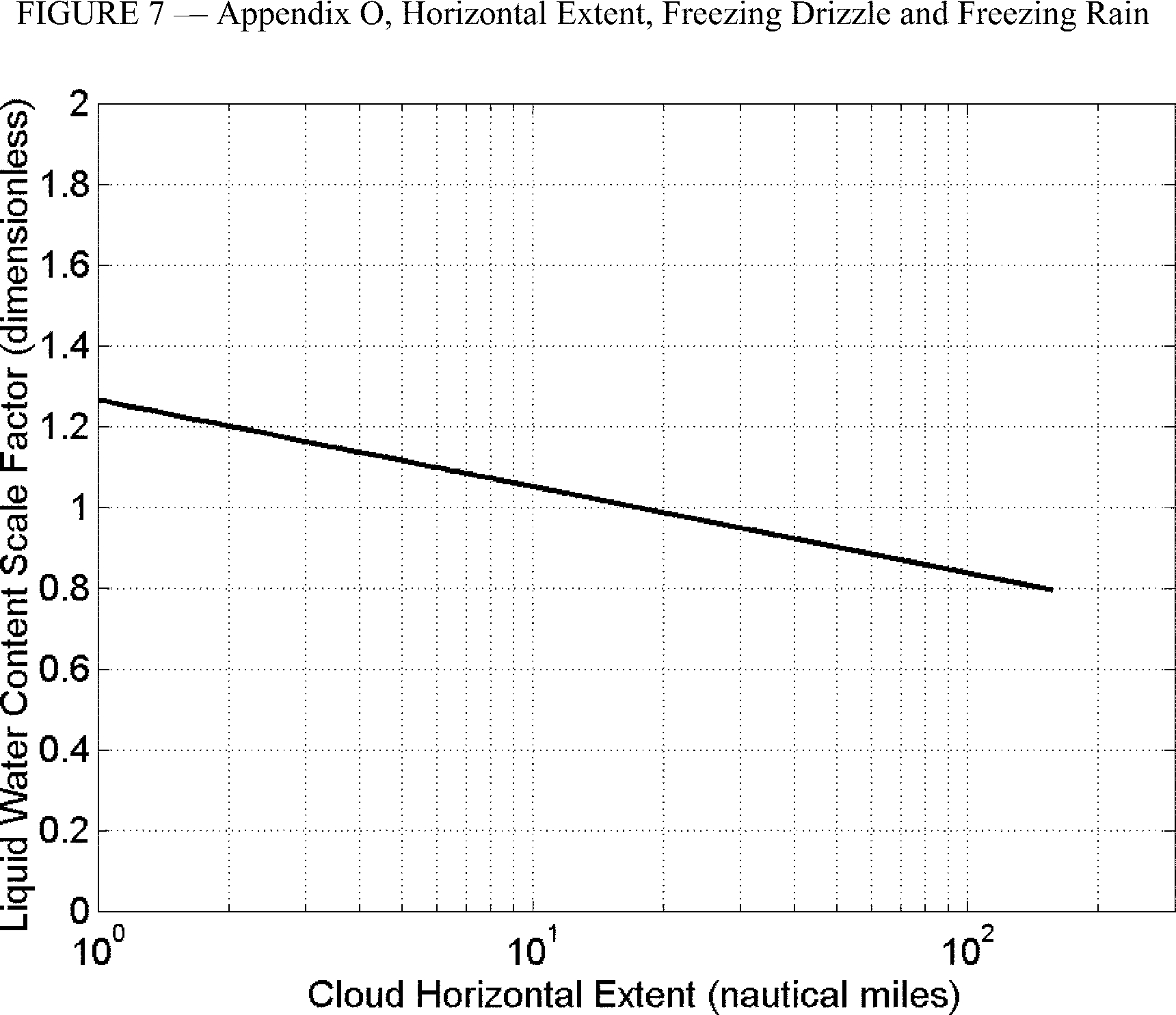Pt. 25, App. O
Appendix O to Part 25—Supercooled Large Drop Icing Conditions
This Appendix consists of two parts. Part I defines this Appendix as a description of supercooled large drop icing conditions in which the drop median volume diameter (MVD) is less than or greater than 40 µm, the maximum mean effective drop diameter (MED) of Appendix C of this part continuous maximum (stratiform clouds) icing conditions. For this Appendix, supercooled large drop icing conditions consist of freezing drizzle and freezing rain occurring in and/or below stratiform clouds. Part II defines ice accretions used to show compliance with the airplane performance and handling qualities requirements of subpart B of this part.
PART I—METEOROLOGY
In this Appendix icing conditions are defined by the parameters of altitude, vertical and horizontal extent, temperature, liquid water content, and water mass distribution as a function of drop diameter distribution.
(a) Freezing Drizzle (Conditions with spectra maximum drop diameters from 100µm to 500 µm):
(1) Pressure altitude range: 0 to 22,000 feet MSL.
(2) Maximum vertical extent: 12,000 feet.
(3) Horizontal extent: Standard distance of 17.4 nautical miles.
(4) Total liquid water content.
Note: Liquid water content (LWC) in grams per cubic meter (g/m3) based on horizontal extent standard distance of 17.4 nautical miles.
(5) Drop diameter distribution: Figure 2.
(6) Altitude and temperature envelope: Figure 3.
(b) Freezing Rain (Conditions with spectra maximum drop diameters greater than 500 µm):
(1) Pressure altitude range: 0 to 12,000 ft MSL.
(2) Maximum vertical extent: 7,000 ft.
(3) Horizontal extent: Standard distance of 17.4 nautical miles.
(4) Total liquid water content.
Note: LWC in grams per cubic meter (g/m3) based on horizontal extent standard distance of 17.4 nautical miles.
(5) Drop Diameter Distribution: Figure 5.
(6) Altitude and temperature envelope: Figure 6.
(c) Horizontal extent.
The liquid water content for freezing drizzle and freezing rain conditions for horizontal extents other than the standard 17.4 nautical miles can be determined by the value of the liquid water content determined from Figure 1 or Figure 4, multiplied by the factor provided in Figure 7, which is defined by the following equation:
S = 1.266 − 0.213 log10(H)
Where:
S = Liquid Water Content Scale Factor (dimensionless) and
H = horizontal extent in nautical miles







PART II—AIRFRAME ICE ACCRETIONS FOR SHOWING COMPLIANCE WITH SUBPART B OF THIS PART
(a) General. The most critical ice accretion in terms of airplane performance and handling qualities for each flight phase must be used to show compliance with the applicable airplane performance and handling qualities requirements for icing conditions contained in subpart B of this part. Applicants must demonstrate that the full range of atmospheric icing conditions specified in part I of this Appendix have been considered, including drop diameter distributions, liquid water content, and temperature appropriate to the flight conditions (for example, configuration, speed, angle of attack, and altitude).
(1) For an airplane certified in accordance with § 25.1420(a)(1), the ice accretions for each flight phase are defined in part II, paragraph (b) of this Appendix.
(2) For an airplane certified in accordance with § 25.1420(a)(2), the most critical ice accretion for each flight phase defined in part II, paragraphs (b) and (c) of this Appendix, must be used. For the ice accretions defined in part II, paragraph (c) of this Appendix, only the portion of part I of this Appendix in which the airplane is capable of operating safely must be considered.
(3) For an airplane certified in accordance with § 25.1420(a)(3), the ice accretions for each flight phase are defined in part II, paragraph (c) of this Appendix.
(b) Ice accretions for airplanes certified in accordance with § 25.1420(a)(1) or (2).
(1) En route ice is the en route ice as defined by part II, paragraph (c)(3), of this Appendix, for an airplane certified in accordance with § 25.1420(a)(2), or defined by part II, paragraph (a)(3), of Appendix C of this part, for an airplane certified in accordance with § 25.1420(a)(1), plus:
(i) Pre-detection ice as defined by part II, paragraph (b)(5), of this Appendix; and
(ii) The ice accumulated during the transit of one cloud with a horizontal extent of 17.4 nautical miles in the most critical of the icing conditions defined in part I of this Appendix and one cloud with a horizontal extent of 17.4 nautical miles in the continuous maximum icing conditions defined in Appendix C of this part.
(2) Holding ice is the holding ice defined by part II, paragraph (c)(4), of this Appendix, for an airplane certified in accordance with § 25.1420(a)(2), or defined by part II, paragraph (a)(4), of Appendix C of this part, for an airplane certified in accordance with § 25.1420(a)(1), plus:
(i) Pre-detection ice as defined by part II, paragraph (b)(5), of this Appendix; and
(ii) The ice accumulated during the transit of one cloud with a 17.4 nautical miles horizontal extent in the most critical of the icing conditions defined in part I of this Appendix and one cloud with a horizontal extent of 17.4 nautical miles in the continuous maximum icing conditions defined in Appendix C of this part.
(iii) Except the total exposure to holding ice conditions does not need to exceed 45 minutes.
(3) Approach ice is the more critical of the holding ice defined by part II, paragraph (b)(2), of this Appendix, or the ice calculated in the applicable paragraphs (b)(3)(i) or (ii) of part II, of this Appendix:
(i) For an airplane certified in accordance with § 25.1420(a)(2), the ice accumulated during descent from the maximum vertical extent of the icing conditions defined in part I of this Appendix to 2,000 feet above the landing surface in the cruise configuration, plus transition to the approach configuration, plus:
(A) Pre-detection ice, as defined by part II, paragraph (b)(5), of this Appendix; and
(B) The ice accumulated during the transit at 2,000 feet above the landing surface of one cloud with a horizontal extent of 17.4 nautical miles in the most critical of the icing conditions defined in part I of this Appendix and one cloud with a horizontal extent of 17.4 nautical miles in the continuous maximum icing conditions defined in Appendix C of this part.
(ii) For an airplane certified in accordance with § 25.1420(a)(1), the ice accumulated during descent from the maximum vertical extent of the maximum continuous icing conditions defined in part I of Appendix C to 2,000 feet above the landing surface in the cruise configuration, plus transition to the approach configuration, plus:
(A) Pre-detection ice, as defined by part II, paragraph (b)(5), of this Appendix; and
(B) The ice accumulated during the transit at 2,000 feet above the landing surface of one cloud with a horizontal extent of 17.4 nautical miles in the most critical of the icing conditions defined in part I of this Appendix and one cloud with a horizontal extent of 17.4 nautical miles in the continuous maximum icing conditions defined in Appendix C of this part.
(4) Landing ice is the more critical of the holding ice as defined by part II, paragraph (b)(2), of this Appendix, or the ice calculated in the applicable paragraphs (b)(4)(i) or (ii) of part II of this Appendix:
(i) For an airplane certified in accordance with § 25.1420(a)(2), the ice accretion defined by part II, paragraph (c)(5)(i), of this Appendix, plus a descent from 2,000 feet above the landing surface to a height of 200 feet above the landing surface with a transition to the landing configuration in the icing conditions defined in part I of this Appendix, plus:
(A) Pre-detection ice, as defined in part II, paragraph (b)(5), of this Appendix; and
(B) The ice accumulated during an exit maneuver, beginning with the minimum climb gradient required by § 25.119, from a height of 200 feet above the landing surface through one cloud with a horizontal extent of 17.4 nautical miles in the most critical of the icing conditions defined in part I of this Appendix and one cloud with a horizontal extent of 17.4 nautical miles in the continuous maximum icing conditions defined in Appendix C of this part.
(ii) For an airplane certified in accordance with § 25.1420(a)(1), the ice accumulated in the maximum continuous icing conditions defined in Appendix C of this part, during a descent from the maximum vertical extent of the icing conditions defined in Appendix C of this part, to 2,000 feet above the landing surface in the cruise configuration, plus transition to the approach configuration and flying for 15 minutes at 2,000 feet above the landing surface, plus a descent from 2,000 feet above the landing surface to a height of 200 feet above the landing surface with a transition to the landing configuration, plus:
(A) Pre-detection ice, as described by part II, paragraph (b)(5), of this Appendix; and
(B) The ice accumulated during an exit maneuver, beginning with the minimum climb gradient required by § 25.119, from a height of 200 feet above the landing surface through one cloud with a horizontal extent of 17.4 nautical miles in the most critical of the icing conditions defined in part I of this Appendix and one cloud with a horizontal extent of 17.4 nautical miles in the continuous maximum icing conditions defined in Appendix C of this part.
(5) Pre-detection ice is the ice accretion before detection of flight conditions in this Appendix that require exiting per § 25.1420(a)(1) and (2). It is the pre-existing ice accretion that may exist from operating in icing conditions in which the airplane is approved to operate prior to encountering the icing conditions requiring an exit, plus the ice accumulated during the time needed to detect the icing conditions, followed by two minutes of further ice accumulation to take into account the time for the flightcrew to take action to exit the icing conditions, including coordination with air traffic control.
(i) For an airplane certified in accordance with § 25.1420(a)(1), the pre-existing ice accretion must be based on the icing conditions defined in Appendix C of this part.
(ii) For an airplane certified in accordance with § 25.1420(a)(2), the pre-existing ice accretion must be based on the more critical of the icing conditions defined in Appendix C of this part, or the icing conditions defined in part I of this Appendix in which the airplane is capable of safely operating.
(c) Ice accretions for airplanes certified in accordance with §§ 25.1420(a)(2) or (3). For an airplane certified in accordance with § 25.1420(a)(2), only the portion of the icing conditions of part I of this Appendix in which the airplane is capable of operating safely must be considered.
(1) Takeoff ice is the most critical ice accretion on unprotected surfaces, and any ice accretion on the protected surfaces, occurring between the end of the takeoff distance and 400 feet above the takeoff surface, assuming accretion starts at the end of the takeoff distance in the icing conditions defined in part I of this Appendix.
(2) Final takeoff ice is the most critical ice accretion on unprotected surfaces, and any ice accretion on the protected surfaces appropriate to normal ice protection system operation, between 400 feet and either 1,500 feet above the takeoff surface, or the height at which the transition from the takeoff to the en route configuration is completed and VFTO is reached, whichever is higher. Ice accretion is assumed to start at the end of the takeoff distance in the icing conditions defined in part I of this Appendix.
(3) En route ice is the most critical ice accretion on the unprotected surfaces, and any ice accretion on the protected surfaces appropriate to normal ice protection system operation, during the en route flight phase in the icing conditions defined in part I of this Appendix.
(4) Holding ice is the most critical ice accretion on the unprotected surfaces, and any ice accretion on the protected surfaces appropriate to normal ice protection system operation, resulting from 45 minutes of flight within a cloud with a 17.4 nautical miles horizontal extent in the icing conditions defined in part I of this Appendix, during the holding phase of flight.
(5) Approach ice is the ice accretion on the unprotected surfaces, and any ice accretion on the protected surfaces appropriate to normal ice protection system operation, resulting from the more critical of the:
(i) Ice accumulated in the icing conditions defined in part I of this Appendix during a descent from the maximum vertical extent of the icing conditions defined in part I of this Appendix, to 2,000 feet above the landing surface in the cruise configuration, plus transition to the approach configuration and flying for 15 minutes at 2,000 feet above the landing surface; or
(ii) Holding ice as defined by part II, paragraph (c)(4), of this Appendix.
(6) Landing ice is the ice accretion on the unprotected surfaces, and any ice accretion on the protected surfaces appropriate to normal ice protection system operation, resulting from the more critical of the:
(i) Ice accretion defined by part II, paragraph (c)(5)(i), of this Appendix, plus ice accumulated in the icing conditions defined in part I of this Appendix during a descent from 2,000 feet above the landing surface to a height of 200 feet above the landing surface with a transition to the landing configuration, followed by a go-around at the minimum climb gradient required by § 25.119, from a height of 200 feet above the landing surface to 2,000 feet above the landing surface, flying for 15 minutes at 2,000 feet above the landing surface in the approach configuration, and a descent to the landing surface (touchdown) in the landing configuration; or
(ii) Holding ice as defined by part II, paragraph (c)(4), of this Appendix.
(7) For both unprotected and protected parts, the ice accretion for the takeoff phase must be determined for the icing conditions defined in part I of this Appendix, using the following assumptions:
(i) The airfoils, control surfaces, and, if applicable, propellers are free from frost, snow, or ice at the start of takeoff;
(ii) The ice accretion starts at the end of the takeoff distance;
(iii) The critical ratio of thrust/power-to-weight;
(iv) Failure of the critical engine occurs at VEF; and
(v) Crew activation of the ice protection system is in accordance with a normal operating procedure provided in the airplane flight manual, except that after beginning the takeoff roll, it must be assumed that the crew takes no action to activate the ice protection system until the airplane is at least 400 feet above the takeoff surface.
(d) The ice accretion before the ice protection system has been activated and is performing its intended function is the critical ice accretion formed on the unprotected and normally protected surfaces before activation and effective operation of the ice protection system in the icing conditions defined in part I of this Appendix. This ice accretion only applies in showing compliance to §§ 25.143(j) and 25.207(h).
(e) In order to reduce the number of ice accretions to be considered when demonstrating compliance with the requirements of § 25.21(g), any of the ice accretions defined in this Appendix may be used for any other flight phase if it is shown to be at least as critical as the specific ice accretion defined for that flight phase. Configuration differences and their effects on ice accretions must be taken into account.
(f) The ice accretion that has the most adverse effect on handling qualities may be used for airplane performance tests provided any difference in performance is conservatively taken into account.
[Amdt. 25-140, 79 FR 65528, Nov. 4, 2014]
